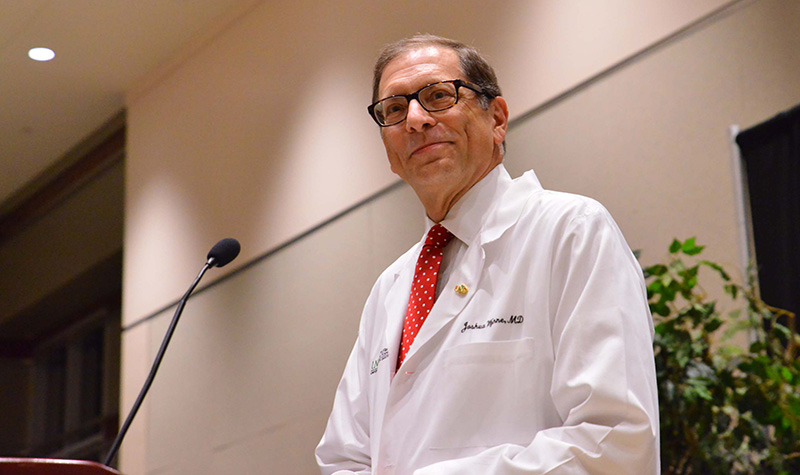From the Dean

The Association of American Medical Colleges (AAMC) is an organization that represents, advises, and assists all the medical schools in the U.S. and Canada. Schools pay a membership fee to belong to it, and in return get a wide array of services. One of the more useful services is access to an extensive database of information and statistics derived from all member schools. This enables each member school to compare its performance with that of other medical schools in the U.S.
So how do we compare? On average, our class size is at the lower end of the scale; we have many fewer employed faculty members; accordingly, the income that the School earns from the clinical practice of its employed clinician faculty members is low, relatively speaking; and the amount of research funding brought into to the School (often from federal sources) is on the low end of the scale when compared with other (generally larger) schools. Some of these comparisons should not surprise us, given our School’s status as a small community-based school that: does not own or operate its own hospital or hospital system; relies on a distributed model of educating its students through the use of three regional campuses (Fargo, Bismarck, and Minot) and a variety of rural sites, in addition to its home campus in Grand Forks; and utilizes a critically important spectrum of non-employed voluntary clinical faculty members who provide the bulk of teaching to our third and fourth-year medical students.
Nor is it surprising that the data show that our medical school class size has increased by about 22 percent since 2010 as a direct result of the Healthcare Workforce Initiative (which is designed to provide more physicians for North Dakota, especially in rural areas, in part through an expansion of class size), or that the ethnic makeup of our class reflects North Dakota rather than the U.S. as a whole. For example, almost seven percent of our class is American Indian, compared with less than one percent nationally at other medical schools. Again, this is no surprise, since we have identified American Indian and rural students in our diversity policy and have worked hard to include more of both groups in our classes. And clearly those efforts are paying off. The fraction of our class that is American Indian, by the way, is close to the fraction of the population of North Dakota that is American Indian.
Perhaps more informative are some trend data. Over time, there has been an upward trend in the Medical College Admission Test (MCAT) scores of SMHS matriculating students, the number of medical school applicants, and the amount of federal grant support awarded to the faculty members at the School. We are especially proud of the latter (that reflects in particular the fantastic efforts of our basic science faculty), because the SMHS recently has shown an 18 percent increase in direct federal research funding while over the same time period the average amount of such funding at other schools decreased overall by five percent. So, relatively speaking, your School showed about a 23 percent increase in federal research funding over the past five years compared with other medical schools.
Just as impressive is the increase in state funding that the School has received in support of the Healthcare Workforce Initiative. Using the AAMC methodology of fund accounting, if we exclude the most recent adjustments in state appropriations, we have experienced a much appreciated increase in state funding over the past few biennia for our operations. I can assure you that each and every faculty and staff member at the School works hard every day to justify the exceptional degree of confidence the Legislature has in us as evidenced by this terrific level of support.
Finally, I’m especially delighted to acknowledge and thank our many generous donors whose philanthropic support supplements the contributions of the people of North Dakota through legislative appropriations. One measure of the importance of those donations is that the market value of our endowments has increased by almost 50 percent over the last several years. This is the result of the many endowment contributions we have received (like the additional exceptionally generous donation made by Dr. David and Lola Monson that I announced recently), along with savvy investing overseen by the UND Alumni Association and Foundation. As a result of the increased giving by our donors that has allowed us to award more scholarships (along with strong financial support from the state), recently we have been able to decrease the average cumulative debt of our graduating medical students by almost one percent per year (0.7) while during the same time period the average medical school debt across the country increased by almost three percent (2.8). This means that over the last five years, the average debt of our students not only decreased but that the change in their debt level was about 18 percent lower than at other schools (using a compounded averaging method). And having lower debt means less emotional stress on students as they make career and practice location decisions. This translates into more students choosing the much-needed primary care specialties like family and general internal medicine and choosing a rural location for clinical practice.
All in all, I’m quite pleased with what these comparison data show. I’ll have some additional observations in future E-News columns, and will keep you apprised of any important developments.
Joshua Wynne, MD, MBA, MPH
UND Vice President for Health Affairs
Dean, UND School of Medicine and Health Sciences



